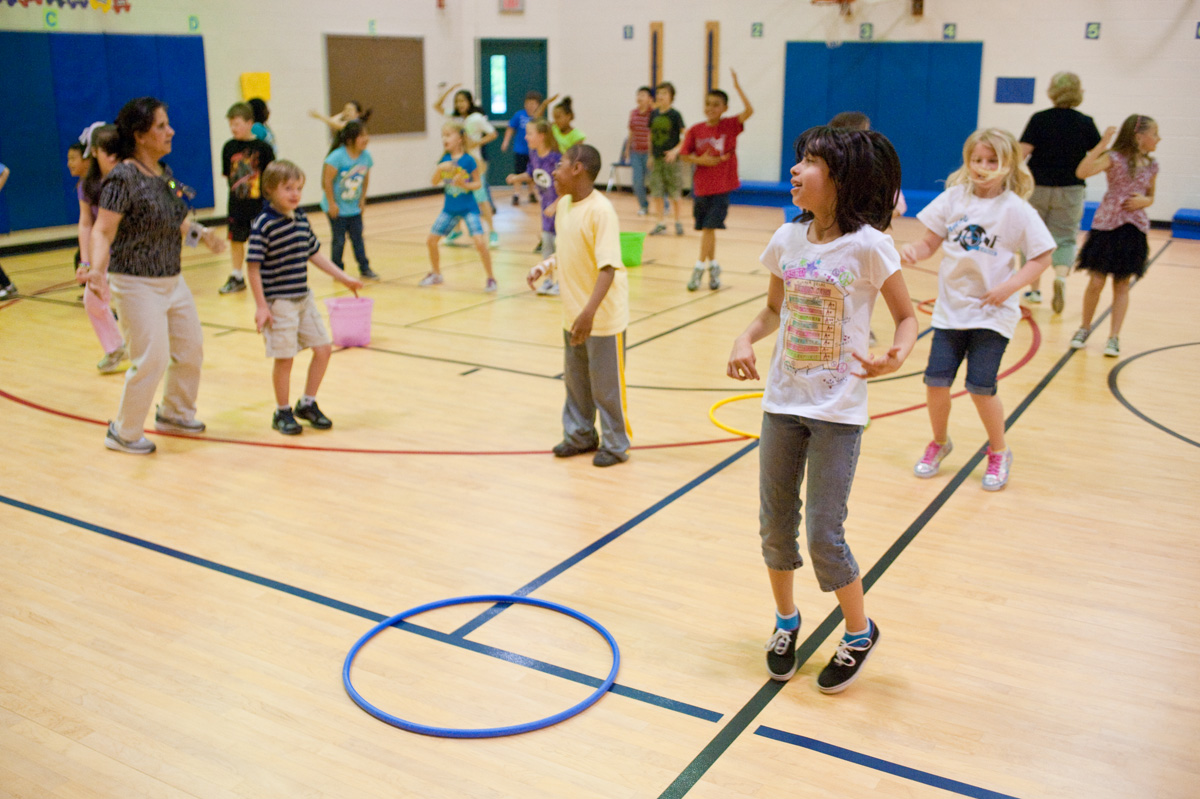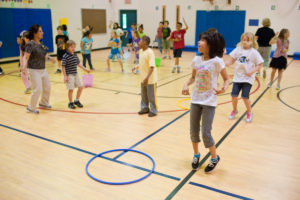Games Kids Love to Play

 Do you remember the playground on a bright spring day, flinging off your coat in a mad dash for the monkey bars or choosing up teams for a fast game of dodgeball? For many of us, these memories of the places and games we played as children are among our most vivid. In the introduction to the recently published 36 Games Kids Love to Play is this account of an opening celebration for a new elementary school:
Do you remember the playground on a bright spring day, flinging off your coat in a mad dash for the monkey bars or choosing up teams for a fast game of dodgeball? For many of us, these memories of the places and games we played as children are among our most vivid. In the introduction to the recently published 36 Games Kids Love to Play is this account of an opening celebration for a new elementary school:
. . . graduates of the old school were invited back to reminisce. Person after person after person—teenager to old-ager—spoke not of the classroom but of the playground. They spoke of the games in general and of specific memories like kicking the ball over the school house roof into the hands of the other team. They remembered what was most important to them. They remembered play.
Play is fun—we all know that. But in addition to giving children a chance to burn off physical energy, to laugh, and to let loose, play provides an opportunity to learn and practice a wide array of physical, cognitive, and social skills. Playing games can build community and if a game is carefully chosen, taught, modeled, and monitored, it can reinforce in children the important qualities of cooperation, assertion, responsibility, empathy, and self-control. Playing games encourages children to move outside their usual circle of friends, challenge themselves, grow.
36 Games Kids Love to Play offers K–4 teachers a wealth of games, from quiet to noisy, brainteasers to tag games. Each game has detailed, clear instructions, as well as helpful hints for the teachers. All the games support development of social skills. Some also support academic skills. The games that follow are excerpted from the book. Adapt as needed for your students and physical space. And most of all—have fun!
Cooperation Hoops
Description of game: In this highly energetic, loud game, the class works together to squeeze as many classmates as possible into a few hula hoops.
Most suitable for: Kindergartners through 4th graders
Requirements:
- 20 minutes the first time the class plays the game (as little as 5 minutes after they’ve learned it)
- An indoor or outdoor space big enough for a number of hula hoops to be scattered about without overlapping
- Approximately 1 hula hoop for every 2 children
Pre-game setup: Scatter the hula hoops on the ground so that they don’t overlap and are roughly equidistant from each other. Because children will be moving energetically around the hoops, make sure all hoops are at least 4 feet away from any furniture or other objects.
How to play
- Children move about the playing area, stepping anywhere except inside a hoop.
- On a signal from the teacher, everyone finds a hoop and steps inside as quickly as possible, helping each other as needed. To be considered “in” a hoop, a child must have at least one foot in. The other foot may not touch the ground outside the hoop.
- After everyone is safely in, everyone steps out again, and one hoop is taken away.
- Steps one and two are repeated again and again, with one less hoop each time. Children will have to be inventive and work together to get all players into an ever-decreasing number of hoops.
- The game continues until children cannot possibly squeeze any more people into the remaining hoops.
Helpful hints
- Use analogies to connect the game with academics. For example:
• If the class is studying planets, you can say, “The hoops are planets, and each student is a spaceship flying around the planets. When you hear a warning call of ‘Landing!’ you must get all the ships to the planets for safety.”
• If you’re studying frogs, you can say, “The hoops are lily pads, and each student is a frog swimming around the pads. When the frog lifeguard calls, ‘Everyone out of the water!’ you need to get all the frogs safely onto the lily pads.” - For added fun, have children use different movements—walking, hopping, skipping, or moving in slow motion—when weaving around the hoops. Build on your analogy. Students can move like a frog, snake, fish, bear, duck, eagle, or chicken. Use your analogy when taking away the hoops, too. “A huge space monster is gobbling up whole planets,” or “A fish is sinking the lily pads.” Children will easily get enthusiastic about a wild and crazy idea.
- Students who are accustomed to competing might have a hard time thinking about how to help each other get inside a hoop, so ask the children to demonstrate how they’ll help each other or demonstrate this yourself with another student.
- Throughout the game, remind the group about helping each other and comment on examples of cooperation that you see.
- When you’ve taken away approximately half the hoops, tell students you don’t think they can possibly squeeze everyone into fewer hoops, then watch them rise to the challenge. I once saw a group of sixteen kindergartners crammed into one hoop, linking arms, hugging each other, with the outermost layer of children teetering on one foot, and everyone standing on tip-toe to make room.
Elephant, Palm Tree, Boat
Description of game: In this fast-paced game, children need to think quickly and work together to pantomime different objects.
Most suitable for: 1st through 4th graders
Requirements:
- 5-10 minutes
- Any indoor or outdoor space big enough for a seated circle
Pre-game setup: None
How to play
- The group sits in a circle. The teacher points to a student and says his or her name, immediately followed by the name of one of three objects. For example: “Breffni, elephant.” This student and the student immediately to the right and to the left stand. The three students then pantomime the named object, using specific movements:
• Elephant—The center person joins both arms together, points them downward, and sways them from side to side to mimic a trunk. The two people on either side make half-circles with their arms to mimic ears.
• Palm tree—The center person raises both arms high in the air and sways them to mimic windblown fronds. The other two people hold their arms out to the side and sway them like a hula dancer.
• Boat—The center person stands on one leg, covers one eye with a hand to pretend to be a pirate, and salutes with the other hand. The people on either side paddle the boat. - When the trio has successfully pantomimed the object, the teacher points to another student: “Shona, boat.” Shona then becomes the middle person of the next trio, who will pantomime a boat.
Helpful hints
- Since children will need to learn and remember nine new movements, it’s important to practice the movements with them before starting the game. With a young class, you might want to begin the game with only one object.
- You can ask the children to suggest new objects or creative movements for depicting them. This allows children to feel ownership of the game.
- Younger children might forget that the trio consists of the named child plus the child to his/her immediate right and left and that only the group of three stands to do a movement. To help them remember, practice calling the name of a student and then having the appropriate group of three stand up.
- When you first play the game, go slowly, allowing plenty of time for the children to make the shapes. As the game progresses, you can pick up the pace.
Tips for Managing Games
(adapted from the introduction to 36 Games Kids Love to Play)
- Children do not necessarily come to school knowing how to play safely or how to include everyone in the fun. Teaching them about this is crucial because children can release themselves to play only when they trust in the safety of their environment.
- To maintain safety, it’s important to teach visual and/or auditory signals that mean “stop immediately” as well as a signal that will gather the children together. Calling “Allee-allee” quickly brings children together; calling “circle up” gets a more orderly group.
- It’s important to teach about safe tagging—a gentle, open-handed touch on the shoulder, arm, or back. It’s also important to teach “tagger’s choice”—if the tagger says s/he tagged you, you are tagged. No arguing.
- Present new games inside, perhaps using drawings or diagrams to help children envision the game. Talk about safety issues that are specific to the game. Model any unusual or tricky movements.
- Join in the game, if you wish, but also keep an active watch on the proceedings.
- Talking about games after they’re played maximizes the learning. Take a few minutes after playing to reflect by asking questions such as, “What made this game work?” “Were there any problems with this game?” “What could we do better next time?”
Keep playing!
